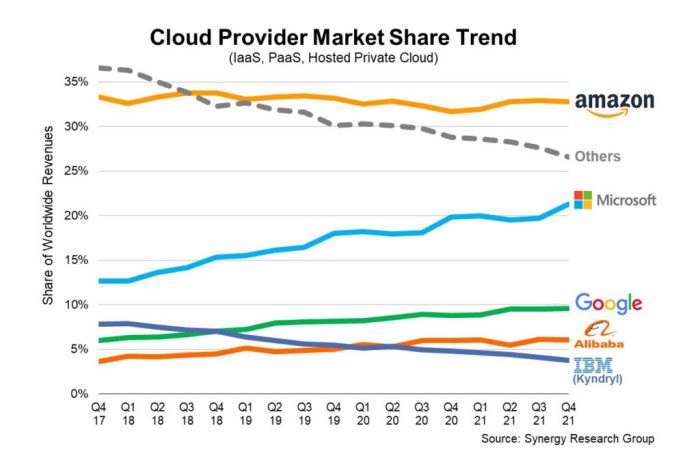
Exploring the world of cloud market share comparison unveils a landscape filled with competition, innovation, and strategic maneuvers. Dive into this engaging narrative that sheds light on the dynamics of market share in the cloud industry.
As we delve deeper, you'll discover the intricacies of collecting and analyzing market share data for cloud services, along with the top companies dominating the market.
Overview of Cloud Market Share Comparison
Comparing market share in the cloud industry is crucial for understanding the competitive landscape and trends within the market. It helps businesses make informed decisions on which cloud service provider to choose based on their market dominance, innovation, and reliability.
Market share data for cloud services is collected through various methods such as surveys, customer feedback, financial reports, and industry analysis. This data is then analyzed to determine the percentage of total market sales that each cloud provider holds, giving insights into their position in the market.
Top Companies Leading in Cloud Market Share
- Amazon Web Services (AWS): As a pioneer in cloud computing, AWS holds a significant portion of the market share with a wide range of services and global infrastructure.
- Microsoft Azure: With a strong presence in enterprise solutions, Azure has been steadily gaining market share and expanding its offerings.
- Google Cloud Platform: Known for its data analytics and machine learning capabilities, Google Cloud Platform has been making strides in the cloud market share competition.
- IBM Cloud: Leveraging its expertise in AI and hybrid cloud solutions, IBM Cloud remains a key player in the cloud market share comparison.
Factors Influencing Market Share in the Cloud Industry
In the highly competitive cloud industry, several key factors play a crucial role in influencing market share. Pricing strategies, innovation, and technology are among the main determinants that impact the success of cloud providers.
Pricing Strategies and Market Share
Pricing strategies are a fundamental aspect that can make or break a cloud provider's market share. Competitive pricing, discounts, and flexible payment options can attract more customers and help in gaining a larger market share. On the other hand, setting prices too high or failing to offer cost-effective solutions can lead to a loss of market share to more affordable competitors.
Innovation and Technology
Innovation and technology are paramount in the cloud industry, where advancements occur rapidly. Cloud providers that invest in cutting-edge technologies, offer new features, and improve their services continuously are more likely to gain market share. Conversely, companies that fail to innovate or adapt to changing trends risk losing market share to more agile and innovative competitors.
Market Share Comparison by Cloud Service Type
In the cloud industry, different types of cloud services like IaaS, PaaS, and SaaS play a crucial role in meeting the diverse needs of businesses. Let's compare the market share data for each type and explore the trends shaping competition in the cloud market.
IaaS (Infrastructure as a Service)
IaaS providers offer virtualized computing resources over the internet, allowing businesses to scale infrastructure as needed. Market leaders like Amazon Web Services (AWS) and Microsoft Azure dominate the IaaS market, with AWS holding a significant market share due to its extensive global infrastructure and services.
PaaS (Platform as a Service)
PaaS solutions provide a platform for developers to build, deploy, and manage applications without worrying about underlying infrastructure. Companies like Google Cloud Platform and Salesforce's Heroku are prominent players in the PaaS market, offering robust development tools and scalability options.
SaaS (Software as a Service)
SaaS applications are software delivered over the internet, eliminating the need for on-premises installations
Regional Variations in Cloud Market Share
When looking at the cloud market share globally, it's important to consider the regional variations that exist. Different regions have unique characteristics that influence how cloud services are adopted and utilized.
North America
- North America has been a leader in cloud adoption, with major players like Amazon Web Services (AWS) and Microsoft Azure dominating the market.
- The tech-savvy culture in the U.S. has contributed to the rapid growth of cloud services in the region.
- Strict data privacy regulations in countries like the U.S. have also influenced the market share of cloud providers.
Europe
- In Europe, data sovereignty laws have a significant impact on cloud market share, with companies preferring local providers to comply with regulations.
- Players like Google Cloud Platform (GCP) and IBM Cloud have gained traction in the European market due to their data protection measures.
- Cultural diversity across European countries also plays a role in shaping cloud adoption and market share.
Asia-Pacific
- Asia-Pacific is a rapidly growing market for cloud services, with players like Alibaba Cloud and Tencent Cloud dominating in China.
- Regulatory differences among countries in the region influence the market share of global cloud providers.
- The rise of digital transformation initiatives in countries like India and Singapore has led to increased adoption of cloud services.
Final Conclusion

In conclusion, the journey through cloud market share comparison has revealed the complexities and nuances of this competitive landscape. From factors influencing market share to regional variations, the cloud industry continues to evolve, setting the stage for new players and innovations.
Q&A
What methods are used to collect market share data in the cloud industry?
Market share data in the cloud industry is typically collected through surveys, financial reports, and analysis of customer usage patterns.
How do pricing strategies impact market share for cloud providers?
Pricing strategies play a crucial role in attracting customers and gaining market share. Competitive pricing can lead to increased market share, while overpricing may result in losing customers to competitors.
Can you provide examples of regional players dominating specific areas in the cloud market?
Yes, for instance, Alibaba Cloud is a dominant player in the Asian market, while Amazon Web Services (AWS) holds a significant share in the North American market.











